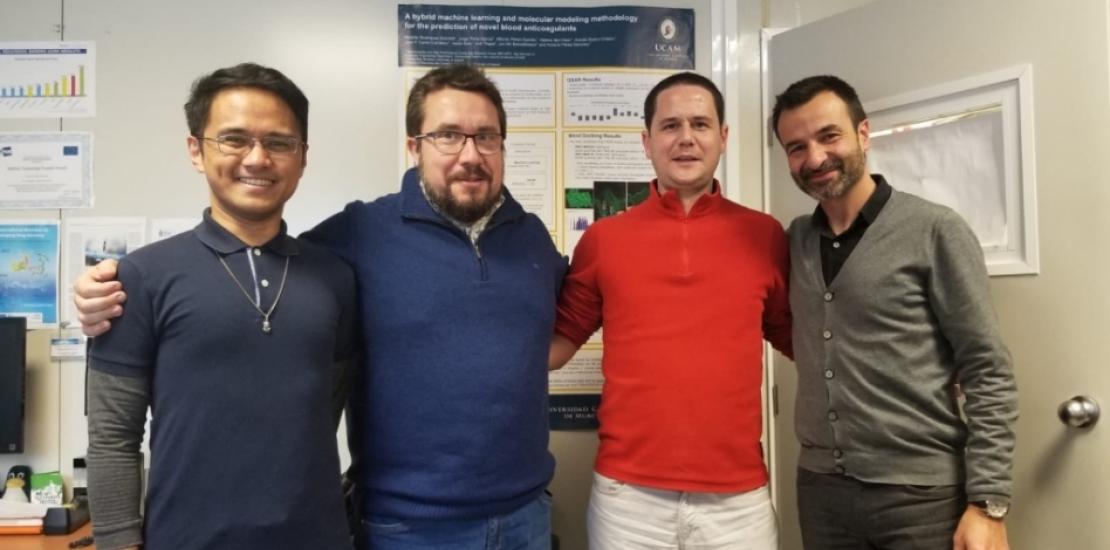Murcian researchers achieve important advances in the fight against arthritis, alzheimer and diabetes
The ‘Nature Chemical Biology’ magazine, from the prestigious group Nature, published recently the results from the researchers from the Murcian Institution of Biosanitary Research of Arrixaca in collaboration with scientists from UCAM and the Hospital Clinic-IDIPBAS, that have discovered the action mechanism of the anti-inflammatory molecule that allows to develop new treatments against arthritis, alzheimer and diabetes
The Molecular Inflammation group from the Murcian Institution of Biosanitary Research, Virgin of Arrixaca (IMIB-Arrizaca), in collaboration with the BIO-HPC group of the Catholic University of Murcia (UCAM) and the Immunology Department of the Hospital Clinic-IDIPBAS (Institute of Biomedical Investigations August Pi i Sunyer) from Barcelona, has managed to accomplish to characterise a molecules anti-inflammatory action that allows more efficient treatments against diseases related to chronic inflammation, such as rheumatoid arthritis, diabetes, alzheimer or parkinson’s disease, between other dominant pathologies of the occidental society.
UCAM investigators, Horacio Pérez and José Pedro Cerón, through computer simulation, have got to know which part of the molecule interacts with the protein, and reveals the mechanism through atomic resolution, for which they used a tool called Blind Docking (BD), designed by the group.
‘Nature Chemical Biology’ magazine, from the prestigious Nature group, published in the recent days the discovery of these researchers, lead by Dr. Pablo Pelegrín, Scientific Subdirector of IMIB, a position that has achieved to unveil the action mechanism of a composition, that was research without accomplishment since the 90’s.
To this day it wasn’t known that all these diseases share a group of proteins, called inflammasome, related to the process of chronic inflammation that produces the expansion of the pathologies mentioned. However, the exact mechanism that certain compositions have over the inflammasome was unknown, and therefore, it was difficult to evolution with new treatments against these diseases. This group of researchers have discovered the way in which the inflammatory reduction is produced in the interaction with a molecule called MCC950.
“We have identificated the action mechanism of this pharmaceutical, the molecule MCC950, created in the 90’s by the pharmaceutical industry Pfizer, that until now its molecular mechanism hadn’t been identified. Using very advanced molecular biology techniques, developed in our laboratory, we have been able to identify, for the first time, the action mechanism of this composition”, Dr. Pelegrín explained.
The significance of this discovery resides in the possibility to design new more efficient and less aggressive medication, that acts directly on the target of this protein with a reduced dosis. Pelegrín added, that “to understand how medication or molecules works is something essential for the clinical development of this composition. It’s going to be fundamental to the future to develop new therapies for the treatment of chronical anti-inflammatory diseases, like ulcerative colitis or rheumatoid arthritis. Or for the treatment of metabolic or degenerative disorders, like diabetes or alzheimer; all of these conditions do not have a definite treatment currently”.
Computerized simulation
Ana Tapia-Abellán, main investigator of the published article in ‘Nature Chemical Biology’ commented on the methodology used in the discovery, “in our laboratory of Molecular Inflammation of IMIB, we have developed a technique that helps us study, in real time and inside of the cells, how these proteins change their conformation. The effect of this medication is that it inhibits the proteins that provoke inflammation”.
This new technique has been able to develop thanks to the contribution of the UCAM researchers, Horacio Pérez and José Pedro Cerón, who have contributed with particular details through computerized simulation to understand, which part of the molecule interacts with the protein, and reveals the mechanism through atomic resolution. For this they used a tool called Blind Docking (BD), designed by the group to process in detail the most important interactions between medication in study and the proteins responsible for the development of disorders.
The action mechanism was validated by investigating the blood samples from patients who present mutations in the inflammasome and chronic inflammation, achieved thanks to Juan Ignacio Arostegui, from the Immunology Service of Hospital Clinic-IDIPBAS.




